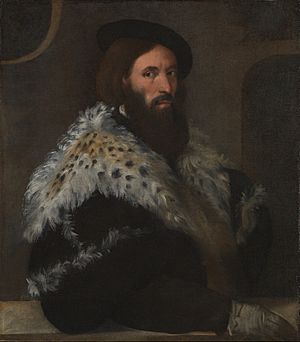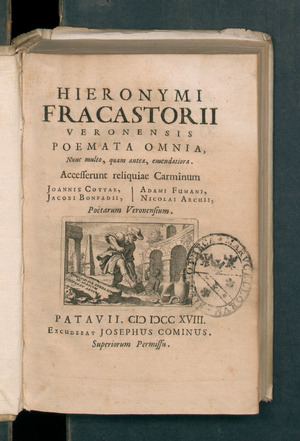Girolamo Fracastoro facts for kids

Girolamo Fracastoro (Latin: Hieronymus Fracastorius; c. 1476/8 – 6 August 1553) was an Italian physician, poet, and scholar in mathematics, geography and astronomy. Fracastoro subscribed to the philosophy of atomism, and rejected appeals to hidden causes in scientific investigation. .....
Contents
Life
Fracastoro was born in Verona, Republic of Venice and educated at Padua where at the age of 19 he was appointed professor at the university. On account of his eminence in the practice of medicine, he was elected physician of the Council of Trent. A bronze statue was erected in his honor by the citizens of Padua, while his native city commemorated their great compatriot with a marble statue. He lived and practised in his hometown. In 1546 he proposed that epidemic diseases are caused by transferable tiny particles or "spores" that could transmit infection by direct contact, indirect contact, or even without contact over long distances. In his writing, the "spores" of diseases may refer to chemicals rather than to any living entities.
He appears to have first used the Latin word fomes, meaning tinder, in the sense of infectious agent, in his essay on contagion De Contagione et Contagiosis Morbis (On Contagion and Contagious Diseases), published in 1546: "I call fomites [from the Latin fomes, meaning "tinder"] such things as clothes, linen, etc., which although not themselves corrupt, can nevertheless foster the essential seeds of the contagion and thus cause infection." His theory remained influential for nearly three centuries, before being superseded by a fully developed germ theory.
..... Syphilus insulted Sol Pater, the god of the Sun, and was punished by him with a horrible disease. The poem suggests using mercury and "guaiaco" as a cure. In 1546 his book (De contagione, "On Contagion") also gave the first description of typhus. The collected works of Fracastoro appeared for the first time in 1555.
..... Joseph was translated under the title The Maidens Blush, or Joseph by Josuah Sylvester. A full edition and English translation of Fracastoro's poetry was prepared by James Gardner for The I Tatti Renaissance Library.
In 1546 Fracastoro described an epidemic in cattle that devastated farmers near Verona, Italy. That disease is now recognized as foot-and-mouth disease (FMD), an animal illness of great antiquity.
A portrait of Fracastoro that has been in the collection of the National Gallery since 1924 has recently been attributed to the renowned Italian painter Titian. .....
Fracastoro's landmarks in Verona
A marble portrait statue of Girolamo Fracastoro by the Carrarese sculptor Danese Cattaneo (completed 1559) stands on a beautiful arch in the central Piazza dei Signori of Verona, near the monument to Dante Alighieri. On its base is the inscription: "HIER FRACASTORIO \ PAULLI PHILIPPI F \ EX PUBLICA AUCTORITATE \ DICATA \ AN SAL MDLIX". According to a popular legend the stone ball Fracastoro holds in his right hand, symbolizing the world, will fall on the first honorable person to walk under the arch. Over the centuries many people have passed every day under the arch, but the ball remains in place.
Fracastoro's landmarks on the Moon
The lunar crater Fracastorius is named after him.
Seeds of disease theory
19th century bacteriologists studied Fracastoro’s works, and his "seeds of disease" theory as a predecessor to germ theory.
Works
- Di Vino Temperatura (1534)
- Homocentricorum sive de Stellis, de Causis Criticorum Dierum Libellus (1535)
- Homocentrica (1538)
- Naugerius sive de Poetica Dialogus (c. 1540)
- De Contagione et Contagiosis Morbis (1546)
See also
 In Spanish: Girolamo Fracastoro para niños
In Spanish: Girolamo Fracastoro para niños




